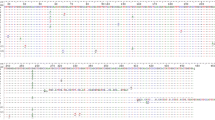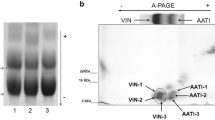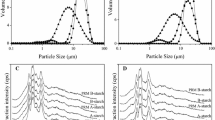Abstract
Hordoindolines, the tryptophan-rich polypeptides affecting grain hardness in barley, appeared as three pairs of polypeptides in the acidic polyacrylamide gel electrophoresis (A-PAGE) and two-dimensional A-PAGE × SDS-PAGE patterns of starch-granule proteins from 18 barley cultivars. On capillary RP-HPLC/nESI-MS/MS spectrometry, one pair of polypeptides was found to correspond to hordoindoline A (HINA), one to hordoindoline B1 (HINB1) and one to hordoindoline B2 (HINB2), the two polypeptides of each pair deriving from post-translational cleavage of a native hordoindoline at different positions at the N-terminus and/or C-terminus. Amongst the barley cultivars analyzed, cvs Hart and Sundance, which were claimed to be unique in lacking the Hina gene coding for HINA, revealed similar Hina coding sequences and accumulated hordoindoline HINA on their starch granules. The amount of total hordoindolines (HINA + HINB1 + HINB2) on the starch granules, as quantified by densitometric scanning of A-PAGE gels, was comparable with that of puroindolines (PINA + PINB) in soft-textured wheat. By contrast, the amount of B-type hordoindolines (HINB1 and HINB2 combined) was 50 % lower than that of PINB, suggesting that the absence of barley cultivars with soft kernels is likely due to the reduced amount of B-type hordoindolines accumulated on the starch granules. Approximately 22 and 27 % of the phenotypic variation for kernel hardness in 56 barley cultivars analyzed by the Single Kernel Characterization System (SKCS) were explained by differences in kernel weight and B-type hordoindoline level, respectively. By contrast, the outer husk of barley grain showed no effect on the SKCS index.


Similar content being viewed by others
References
Allison MJ (1986) Relationships between milling energy and hot water extract values of malts from some modern barleys and their parental cultivars. J Inst Brew 92:604–607
Beecher B, Smidansky ED, See D, Blake TK, Giroux MJ (2001) Mapping and sequence analysis of barley hordoindolines. Theor Appl Genet 102:833–840
Bhave M, Morris CF (2008) Molecular genetics of puroindolines and related genes: allelic diversity in wheat and other grasses. Plant Mol Biol 66:205–219
Blochet J-E, Chevalier C, Forest E, Pebay-Peyroula E, Gautier MF, Joudrier P, Pezolet M, Marion D (1993) Complete amino acid sequence of puroindoline, a new basic and cysteine-rich protein with a unique tryptophan-rich domain, isolated from wheat endosperm by Triton X-114 phase partitioning. FEBS Lett 329:336–340
Bowman JGP, Blake TK, Surber LMM, Habernicht DK, Bockelman H (2001) Feed-quality variation in the barley core collection of the USDA national small grains collection. Crop Sci 41:863–870
Caldwell KS, Russell J, Langridge P, Powell W (2006) Extreme population-dependent linkage disequilibrium detected in an inbreeding plant species, Hordeum vulgare. Genetics 172:557–567
Corona V, Gazza L, Boggini G, Pogna NE (2001a) Variation in friabilin composition as determined by A-PAGE fractionation and PCR amplification, and its relationship to grain hardness in bread wheat. J Cereal Sci 34:243–250
Corona V, Gazza L, Zanier R, Pogna NE (2001b) A tryptophan-to-arginine change in the tryptophan-rich domain of puroindoline b in five French bread wheat cultivars. J Genet Breed 55:187–189
Darlington HF, Rouster J, Hoffmann L, Halford NG, Shewry PR, Simpson DJ (2001) Identification and molecular characterisation of hordoindolines from barley grain. Plant Mol Biol 47:785–794
Fox GP, Osborne B, Bowman J, Kelly A, Cakir M, Poulsen D, Inkerman A, Henry R (2007) Measurement of genetic and environmental variation in barley (Hordeum vulgare) grain hardness. J Cereal Sci 46:82–92
Gamlath J, Aldred GP, Panozzo JF (2008) Barley (1 → 3; 1 → 4)-β-glucan and arabinoxylan content are related to kernel hardness and water uptake. J Cereal Sci 47:365–371
Gautier M-F, Cosson P, Guirao A, Alary R, Joudrier P (2000) Puroindoline genes are highly conserved in diploid ancestor wheats and related species but absent in tetraploid Triticum species. Plant Sci 153:81–91
Gazza L, Nocente F, Ng PKW, Pogna NE (2005) Genetic and biochemical analysis of common wheat cultivars lacking puroindoline a. Theor Appl Genet 110:470–478
Gazza L, Conti S, Taddei F, Pogna NE (2006) Molecular characterization of puroindolines and their encoding genes in Aegilops ventricosa. Mol Breed 17:191–200
Gazza L, Taddei F, Corbellini M, Cacciatori P, Pogna NE (2008) Genetic and environmental factors affecting grain texture in common wheat. J Cereal Sci 47:52–58
Giroux M, Morris CF (1997) A glycine to serine change in puroindoline b is associated with grain hardness and low levels of starch-surface friabilin. Theor Appl Genet 95:857–864
Giroux MJ, Morris CF (1998) Wheat grain hardness results from highly conserved mutations in the friabilin components puroindoline a and b (Triticum aestivum L. grain softness protein). Proc Natl Acad Sci USA 95:6262–6266
Hogg AC, Sripo T, Beecher B, Martin JM, Giroux MJ (2004) Wheat puroindolines interact to form friabilin and control wheat grain hardness. Theor Appl Gen 108:1089–1097
Iwami A, Kajiwara Y, Omori T (2003) Estimating barley character for shochu using a single kernel characterisation system (SKCS). J Inst Brew 109:129–134
Jagtap SS, Beardsley A, Forrest JMS, Ellis RP (1993) Protein composition and grain quality in barley. Asp Appl Biol 36:51–60
Jolly CJ, Rahman S, Kortt AA, Higgins TJV (1993) Characterisation of the wheat Mr 15,000 ‘grain softness protein’ and analysis of the relationship between its accumulation in the whole seed and grain softness. Theor Appl Genet 86:589–597
Mather DE, Tinker NA, LaBerge DE, Edney M, Jones BL, Rossnagel GG, Legge WG, Briggs KG, Irvine RB, Falk DE, Kasha KJ (1997) Regions of the genome that affect grain and malt quality in North American two-row barley cross. Crop Sci 37:544–554
Morrison WR, Greenwell P, Law CN, Sulaiman BD (1992) Occurrence of friabilin, a low molecular weight protein associated with grain softness on starch granules isolated from some wheats and related species. J Cereal Sci 15:143–149
Nagamine T, Sekiwa T, Yamaguchi E, Oozeki MK, Kato M (2009) Relationship between quality parameters and SKCS hardness index in malting barley. J Inst Brew 115:292–295
Swan CG, Meyer FD, Hogg AC, Martin JM, Giroux MJ (2006) Puroindoline B limits binding of puroindoline A to starch and grain softness. Crop Sci 46:1656–1665
Taddei F, Gazza L, Conti S, Muccilli V, Foti S, Pogna NE (2009) Starch-bound 2S proteins and kernel texture in einkorn, Triticum monococcum ssp monococcum. Theor Appl Genet 119:1205–1212
Takahashi A, Ikeda TM, Takayama T, Yanagisawa T (2010) A barley Hordoindoline mutation resulted in an increase in grain hardness. Theor Appl Genet 120:519–526
Thomas WTB, Powell W, Swantson JS, Ellis RP, Chalmers KJ, Barua UM, Jack P, Lea V, Forster BP, Waugh R (1996) Quantitative trait loci for germination and malting quality in a spring barley cross. Crop Sci 36:265–273
Turuspekov Y, Beecher B, Darlington Y, Bowman J, Blake TK, Giroux MJ (2008) Hardness locus sequence variation and endosperm texture in spring barley. Crop Sci 48:1007–1019
Walker CK, Panozzo JF, Ford R, Eckermann P, Moody D, Lehmensiek A, Appels R (2011) Chromosomal loci associated with endosperm hardness in a malting barley cross. Theor Appl Genet 122:151–162
Author information
Authors and Affiliations
Corresponding author
Electronic supplementary material
Below is the link to the electronic supplementary material.
Rights and permissions
About this article
Cite this article
Galassi, E., Gazzelloni, G., Taddei, F. et al. Kernel texture and hordoindoline patterns in barley (Hordeum vulgare). Mol Breeding 30, 1551–1562 (2012). https://doi.org/10.1007/s11032-012-9738-3
Received:
Accepted:
Published:
Issue Date:
DOI: https://doi.org/10.1007/s11032-012-9738-3




